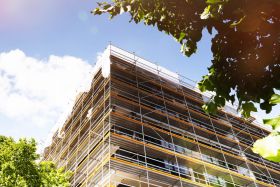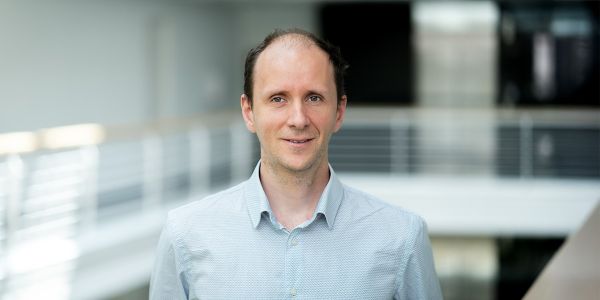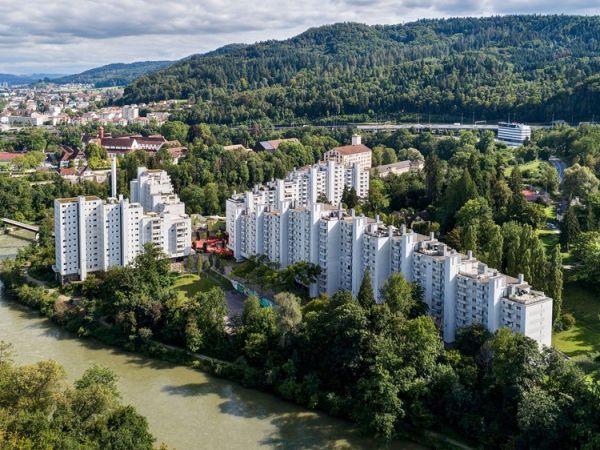

- 368 rented apartments
- Around 1,500 residents
- 1,250 kW heat output
- More than 70 per cent carbon-free
- 30 parking spaces prepared for electromobility
The Webermühle complex in Neuenhof houses 368 rented apartments with 1 to 6 rooms. Situated on a peninsula on the banks of the Limmat river, the development was built on the industrial site of a former weaving mill and was ready to move into in 1984 after ten years of construction. Designed by the architectural firm Steiger Partner AG and built by Ernst Göhner AG, Webermühle offers living spaces of varying sizes for up to 1,500 residents. Despite their very high density, the apartments are located in four rows of high-rise buildings arranged in a cross-shaped pattern and offer surprising panoramic views. The buildings, constructed as part of the ‘Göhner 3’ modular construction system have been owned by a Credit Suisse Asset Management real estate fund since 2008.
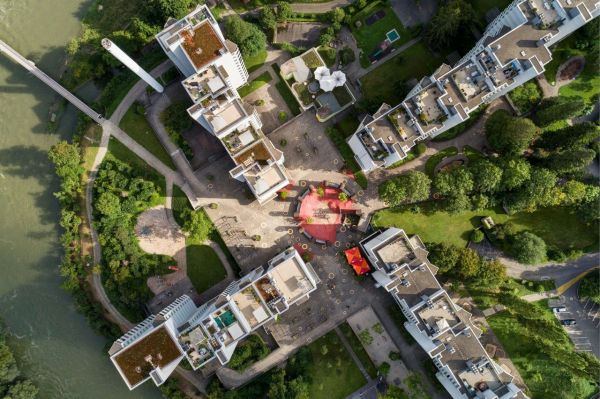
Environmentally and economically sustainable renovation
A good 30 years after being first moved into, the apartments no longer met today’s standards – both in terms of appearance and comfort. In 2009, following analysis of the building fabric, the client started planning a comprehensive partial renovation, which was then carried out in stages between 2012 and 2014 . The portfolio strategy of Credit Suisse Asset Management places great importance on environmentally and economically sustainable solutions. The aim of the modernisation of Webermühle was to make the living and green space more attractive for tenants and to preserve the value of the property. At the same time, the building technology also needed to be brought up to date and energy consumption to be significantly reduced. Improved public transport connections were also an important goal: Wettingen railway station is now just a few minutes’ walk away following construction of a new inclined lift.
Greater interior comfort
All kitchens, bathrooms and toilets were replaced as part of the internal renovation. Bright colours, high-quality, robust materials and modern appliances now ensure a comfortable and friendly home environment. The small-scale floor plans were also broken down in favour of more spacious structures. The entrances and stairwells were also refurbished. As the apartments remained inhabited during the construction work, careful planning was required to ensure that the residents were impacted as little as possible. Information about the upcoming modernisation was provided to tenants at an early stage on a number of occasions .
Energy-efficient renovation of the building envelope
‘To minimise energy losses through the building envelope, replacing all the windows was a key part of the renovation,’ explains Patricia Rupli, who is responsible for managing Webermühle at Wincasa AG. The compact facade was energy-optimised by adding better thermal insulation, which now ensures a pleasant indoor climate in both winter and summer. The roof structures were also renewed and the sun blinds replaced. The previous brown facade now has a fresh, light painted finish. Another measure introduced to reduce energy consumption is the conversion of interior and exterior lighting to LED. All areas should be fitted with it by 2023.
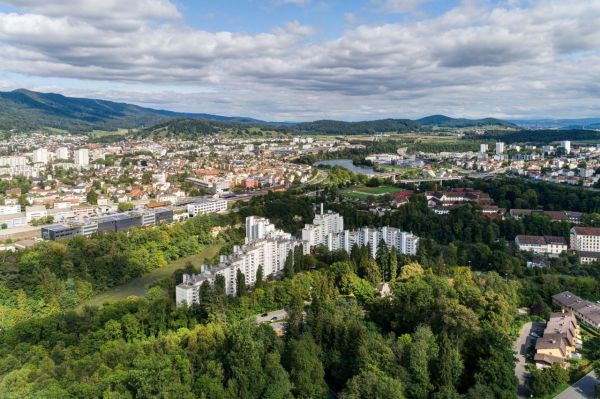
Upgraded external space
The aim of redesigning the surrounding area was to retain the idea of the Gohne developments as a ‘village within a village’. For example, a small shop with a bistro and take-away provides residents with daily essentials. The entire surrounding area, with its large green spaces for leisure activities, games and barbecue areas as well as recreational areas, was upgraded and adapted to current needs.
Parking spaces prepared for electromobility
As part of the 2020/2021 renovation stage, the underground car park also underwent a facelift. ‘We have also prepared 30 of the more than 400 parking spaces with all of the installations needed for electromobility, so that only the charging station needs to be attached. If a tenant registers an interest in having a charging station, it can be put in place quickly ,’ says Patricia Rupli.
Heat supply: Switch to river heat
The realignment of the heating supply is at the heart of the energy-efficient renovation. To this end, the client defined a clear goal: In future, the Webermühle heat supply should be at least 70 per cent carbon-free. Due to the size of the facility, Credit Suisse Asset Management wanted to replace the heating system with a contractor, instead of producing heat itself. Even after a detailed review by teams of specialists, the sustainability of our proposed solution using a river water heat pump impressed the client .
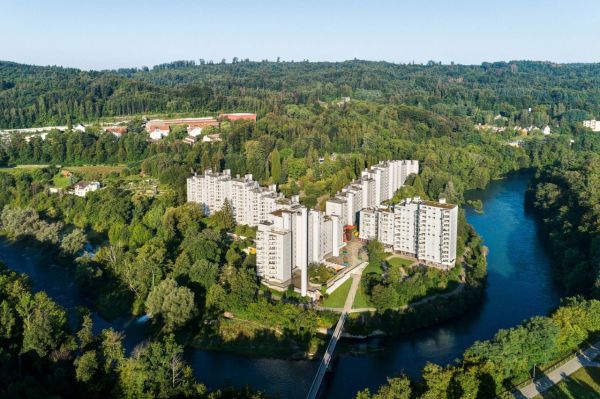
Ideal topography
According to our project manager Pascal Leumann, the surroundings of the Webermühle with the Limmat and an upstream peninsula proved to be ideal for river water use. The geodetic height difference between the extraction and return point is almost 6 metres. This natural gradient ensures there is sufficient pressure for the river water to flow from the extraction point through the pipes and heat exchanger to the return point. The advantage of this is that no electricity-powered source pump is required, which saves a lot of power. The water is collected in the river water catchment in a tributary of the Limmat and transported to the heating plant. The heat is transferred to the intermediate circuit via a heat exchanger. A heat pump raises it to the required level of 60 °C for heating purposes. Five substations – one for each building complex – provide heat to the apartments, which are equipped with radiators. Should the river water system ever fail, one of the two previously used gas boilers is available. This redundancy provides security and also helps to cover peak loads. ‘In the planning phase, we designed our system in a rather conservative way with around 80 per cent carbon-free heat,’ explains Pascal Leumann. Thanks to continuous optimisation in the initial years of operation and an optimal set-up, the coverage in 2020 amounted to 87 per cent, significantly above the 70 per cent specified by the client.
Environmental benefits
Supplying Webermühle with heat from the river is an extremely environmentally friendly solution, not only because it uses the ambient heat provided by the water from the Limmat , but also because the heat production on site eliminates long transport routes and the heat pump is operated using 100 per cent renewable electricity . The natural terrain also offers the ideal conditions for operating without a source pump. The use of river water also causes no problem for the flora and fauna of the Limmat. The heat extraction of around 4 Kelvin helps the returned water to cool the Limmat slightly – a welcome side-effect in view of the ever warmer temperatures.
Reduced workload thanks to contracting
As a contractor, we are responsible for planning, implementing, financing, operating and maintaining the heating solution. If a malfunction occurs anywhere in the system, a report is sent to our specialist responsible for the installation . The faults can often be rectified directly via remote monitoring. Contracting is also an advantage for Wincasa: ‘For the 30-year contract term, ewz is responsible for the entire operation of the heating supply, right up to the building connection, which also greatly reduces our workload as a real estate service provider,’ says Patricia Rupli, Manager at Wincasa AG.
